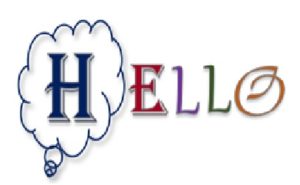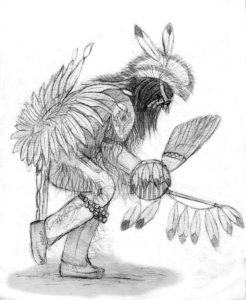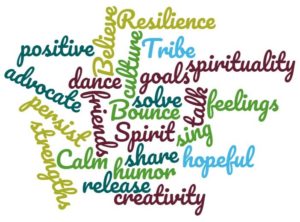April 2018
A product of NAPTAC
Native American Parent Technical Assistance Center
Written by Joann Sebastian Morris
Brief in PDF | Visit the Native American Resource Collection

This message comes to you from your local Parent Center. We connect Native people in the community with disability resources— people like your parents, other relatives, teens, and community leaders. We write this particular message just to you and your friends as Native youth.
__________________
There’s a word you need to know, if you don’t know it already, and that word is resilience, the focus of this message. Resilience “… means ‘bouncing back’ from difficult experiences.” A Lakota author describes resilience as “… being strong on the inside, having a courageous spirit.”
Resilience: What Is It and How Does It Apply To Me?
Consider these interesting facts. Even though your ancestors didn’t know or use the word resilience, it was part of their daily lives, especially when it came to child-rearing. American Indians and Alaska Natives (AI/ANs) shared a common belief that all children—whether they were born with a disability or not—were gifts from the Creator. Many family members and clan relatives had unique roles to play in providing guidance to the young to make them strong and resilient.
 Due to cultural strife, loss of homelands, boarding school experiences, and other factors, the resilience of AI/AN communities was weakened. Thankfully, aspects of traditional Native values and behaviors have survived. Strengths such as tribal identity, language, traditions, stories, and spirituality supported your ancestors, and they continue to be powerful supports today—to you, to your family and friends, and to your Native community.
Due to cultural strife, loss of homelands, boarding school experiences, and other factors, the resilience of AI/AN communities was weakened. Thankfully, aspects of traditional Native values and behaviors have survived. Strengths such as tribal identity, language, traditions, stories, and spirituality supported your ancestors, and they continue to be powerful supports today—to you, to your family and friends, and to your Native community.
In a moment, we’ll share some useful ways to build upon your innate strengths and abilities, and to foster an inner resilience that will be an invaluable ally throughout your life. But first…
Why Is Resilience Important?
Being resilient and “strong on the inside” doesn’t mean that you won’t still experience difficulties in life. It means that you’ve learned the behaviors, thoughts, skills, and actions to help you bounce back from a setback.
For example, being born with or acquiring a disability can cause major stress, whether the disability is visible to others or not. Reinforcing your coping skills makes it less likely that you’ll be overwhelmed by all the other ups and downs of growing up.
How Do I Build and Re-Energize My Resilience?
 Okay, it’s time to check out the 10 skills known to be builders of resilience in youth. They can result in lifelong benefits to you.
Okay, it’s time to check out the 10 skills known to be builders of resilience in youth. They can result in lifelong benefits to you.
Build Relationships
Make supportive friends you can trust, especially in cross-cultural situations. Engage extended family members. Learn social skills and how to be a good friend. Join teams, clubs, or social causes to expand networks. Connect to your tribal identity, participate in local or inter-tribal pow-wows, volunteer at urban Indian Centers and/or organizations, or help elders in the Native community.
Set Goals
Your goals should be personal and can relate to academic steps or hobbies. Ensure your goals are realistic. Break goals into smaller steps, then achieve the steps—and celebrate! Cultural goals may include: making your traditional regalia, learning your Native language, memorizing traditional stories or ceremonial protocols, and engaging in traditional games.
Be a Problem-Solver
Face your problems instead of wishing them away. Learn ways to self-calm when you feel stressed. Use problem-solving skills. Brainstorm solutions—for example, what to do when you are bullied for being Native and/or for your disability.
Hang in There!
Don’t give up. Focus on your unique strengths and accomplishments to date, such as the classroom and testing accommodations you’ve secured for your disability. Be committed to yourself, your family, and your Native community. Hold on to the desire to give back.
Develop Inner Direction
Learn to base your decisions on an internal ability to evaluate social situations. Distance yourself from unhealthy people & uncomfortable situations. Use life skills, such as good decision-making, communication skills, assertiveness, and impulse control. Take time to practice potentially risky scenarios—for example, what to do or say when pressured by substance abusers.
Foster Your Sense of Humor
Use your imagination to see both sides of a difficult situation—the serious and the humorous—which helps keep things in perspective. Use humor appropriately to diffuse a tense situation.
Stay Optimistic
Have confidence in yourself, your abilities, and your future. Recognize your strengths and progress made in school, on a hobby, and in adjusting constructively to your disability. Advocate for yourself with assurance in all Individualized Education Program (IEP) meetings.
Let Your Creativity Shine
Express yourself and release your feelings through writing, art, music, dance, etc. Be good at a cultural skill: Indian dancing, drumming, beadwork, silverwork, story-telling, or being a good listener.
Manage Your Feelings
Don’t let your feelings overwhelm you. Talk with a trusted friend, adult, elder, or spiritual mentor. Participate in talking circles. Discuss fears associated with sensitive topics like a close friend being missing or suicidal, or negative feelings about how you’re treated due to your disability.
Hold on to Spirituality
Believe in a higher power. Practice positive thinking and/or meditation. Express your spirituality through Native ceremonies, sweat lodges, smudging, church attendance, and other forms of ritual, prayer, and searches for balance.
NAPTAC Note
NAPTAC was the Native American Parent Technical Assistance Center, funded by the Office of Special Education Programs (OSEP) at the U.S. Department of Education for several years to develop materials that Parent Centers around the country could use to support the training and information they offer to Native American and Alaska Native parents whose lives are impacted by disability. This document was produced under U.S. Department of Education, Office of Special Education Programs No. H328R130012-14. The views expressed herein do not necessarily represent the positions or policies of the Department of Education. No official endorsement by the U.S. Department of Education of any product, commodity, service, or enterprise mentioned in this publication is intended or should be inferred. This product is in the public domain and is now housed at CPIR, as part of its Native American Resource Collection. You are free to copy and share it, giving the citation as:
Morris, J.S. (2018). Bouncing back from setbacks: A message for American Indian and Alaska Native youth. Albuquerque, NM: NAPTAC. Available online at: https://www.parentcenterhub.org/naptac-tier3-education-youth

